|
|
Convention on the Rights of the Child
New York, 20 November 1989
- Introductory Note
- Procedural History
- Documents
- Status
- Video
- Photo
F o r t h c o m i n g
Introductory note to be published
 The Convention on the Rights of the Child entered into force on 2 September 1990, thirty days after the date of deposit of the twentieth instrument of ratification, as provided for in its article 49. States parties to the Convention on the Rights of the Child have committed to respect and ensure the civil, political, economic, social and cultural rights of children. The Convention provides for the realization of these rights by setting standards for health, education, legal, civil, and social services for children. The Convention on the Rights of the Child entered into force on 2 September 1990, thirty days after the date of deposit of the twentieth instrument of ratification, as provided for in its article 49. States parties to the Convention on the Rights of the Child have committed to respect and ensure the civil, political, economic, social and cultural rights of children. The Convention provides for the realization of these rights by setting standards for health, education, legal, civil, and social services for children.
The General Assembly decided to include the question of a convention on the rights of the child in its provisional agenda of work for its thirty-fourth session of 1979—the International Year of the Child. The Commission on Human Rights subsequently established an open-ended working group to prepare a draft convention. Ten years later, in 1989, a draft convention was completed by the working group and transmitted through the Economic and Social Council, to the General Assembly. The General Assembly adopted the Convention on 20 November 1989—the thirtieth anniversary of the Declaration of the Rights of the Child.
Three optional protocols to the Convention have been adopted by the General Assembly. The Optional Protocol to the Convention on the sale of children, child prostitution and child pornography was adopted on 25 May 2000 and came into force on 18 January 2002. It requires States parties to prohibit the sale of children, child prostitution and child pornography. The Optional Protocol to the Convention on the involvement of children in armed conflict was also adopted on 25 May 2000 and came into force on 12 February 2002. It requires States parties to take all feasible measures to ensure that children do not take a direct part in hostilities. The Optional Protocol to the Convention on a communications procedure was adopted on 19 December 2011 and came into force on 14 April 2014. It provides a mechanism for the submission of communications by or on behalf of an individual or group claiming to be victims of a violation of the Convention. Communications submitted under this Optional Protocol are received and considered by the Committee on the Rights of the Child, which was established under the Convention.
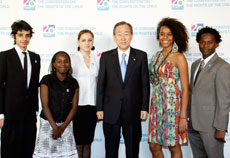 The focus of the United Nations upon the topic of the rights of the child had begun at a very early stage, with the General Assembly examining the issue with regularity. By resolution 1386 (XIV) of 20 November 1959, the General Assembly unanimously adopted the Declaration of the Rights of the Child. By resolution 31/169 of 21 December 1976, the Assembly proclaimed 1979 as the International Year of the Child, with the general objective “to provide a framework for advocacy on behalf of children and for enhancing the awareness of the special needs of children on the part of decision-makers and the public”. The focus of the United Nations upon the topic of the rights of the child had begun at a very early stage, with the General Assembly examining the issue with regularity. By resolution 1386 (XIV) of 20 November 1959, the General Assembly unanimously adopted the Declaration of the Rights of the Child. By resolution 31/169 of 21 December 1976, the Assembly proclaimed 1979 as the International Year of the Child, with the general objective “to provide a framework for advocacy on behalf of children and for enhancing the awareness of the special needs of children on the part of decision-makers and the public”.
On 7 February 1978, Poland submitted to the Commission on Human Rights a draft convention on the rights of the child (E/CN.4/L.1366/Rev.1). In its proposal, Poland recalled the 1959 Declaration of the Rights of the Child and recommended to the Assembly the adoption of an international legally binding instrument in the form of a Convention on the Rights of the Child that would be based on the principles and provisions contained in the said Declaration.The draft convention was considered by the Commission on Human Rights at its thirty-fourth session and was annexed to resolution 20 (XXXIV) adopted by the Commission on 8 March 1978, which recommended its adoption by the Economic and Social Council. In its resolution, the Commission also requested the Secretary-General to transmit the draft convention to Member States, specialized agencies and regional intergovernmental and non-governmental organizations for their views and suggestions. The Commission further decided that it would examine the draft at its thirty-fifth session, in 1979, with a view to submitting a completed draft to the General Assembly.
On 5 May 1978, the Economic and Social Council adopted without vote resolution 1978/18, by which it recommended that the General Assembly consider, at its thirty-fourth session, in 1979, the question of the adoption of a convention on the rights of the child.
Throughout examination of this item (the Convention as well as its Optional Protocols thereto), the Third Committee of the General Assembly made recommendations for adoption by the plenary. Accordingly, by resolution 33/166 of 20 December 1978, the General Assembly decided to include the question of a convention on the rights of the child in its provisional agenda of work at its thirty-fourth session, requesting the Commission on Human Rights to organize its work on the draft convention at its next session so that the draft of the Convention may be ready for adoption, if possible, during the International Year of the Child in 1979.
In 1979, at its thirty-fifth session, the Commission on Human Rights established an open-ended working group to consider the question of a convention on the rights of the child. At the end of its session, the Commission decided to continue its work on the draft convention at its thirty-sixth session in 1980, as a matter of priority (resolution 19 A (XXXV) of 14 March 1979). On the recommendation of the Commission, the Economic and Social Council brought to the attention of the General Assembly the Commission’s discussion and action on this subject (Economic and Social Council decision 1979/37 of 10 May 1979). On 21 September 1979, the General Assembly decided to postpone its consideration of this agenda item until its thirty-fifth session in 1980 (decision 34/402).
From 1980 to 1987, the Commission on Human Rights continued its work on the draft convention in the form of an open-ended working group during its annual sessions. The Economic and Social Council annually authorized meetings of an open-ended working group (decisions 1980/138 of 2 May 1980 and 1981/144 of 8 May 1981, resolutions 1982/37 of 7 May 1982, 1983/39 of 27 May 1983, 1984/25 of 24 May 1984, 1985/42 of 30 May 1985, 1986/40 of 23 May 1986 and 1987/58 of 29 May 1987). The General Assembly also annually requested the Commission to continue to give high priority to the completion of the draft convention (resolutions 35/131 of 11 December 1980, 36/57 of 25 November 1981, 37/190 of 18 December 1982, 38/114 of 16 December 1983, 39/135 of 14 December 1984, 40/113 of 13 December 1985, 41/116 of 4 December 1986 and 42/101 of 7 December 1987).
In 1988, the open-ended working group of the Commission on Human Rights completed the first reading of the draft convention and began the second reading. It adopted the draft convention on second reading in 1989 (E/CN.4/1989/29). The Commission on Human Rights thus decided to adopt the draft convention as submitted by the working group and to transmit it to the General Assembly through the Economic and Social Council (resolution 1989/57 of 8 March 1989). On 24 May 1989, the Economic and Social Council decided to submit the draft convention to the General Assembly with a view to its adoption (resolution 1989/79) and, on 16 October 1989, the Secretary-General transmitted the text of the draft convention to the Assembly (A/44/616). At the forty-fourth session of the General Assembly, the draft convention was discussed in the Third Committee from 9 October to 16 November 1989. The report of the Third Committee (A/44/736 and Corr.1) was considered by the General Assembly on 20 November 1989 (A/44/PV.61). On the same day, the Convention on the Rights of the Child was adopted by the General Assembly and opened for signature, ratification and accession (resolution 44/25). It entered into force on 2 September 1990, thirty days after the date of deposit of the twentieth instrument of ratification, as provided for in its article 49.
Optional protocols
On 5 March 1993, the Committee on the Rights of the Child published a preliminary draft optional protocol (CRC/C/16) on the involvement of children in armed conflict and asked the Secretary-General to transmit it to the Commission on Human Rights in 1994.
On 9 March 1994, the Commission on Human Rights decided to establish an open-ended working group to elaborate a draft optional protocol on the involvement of children in armed conflict and to use the preliminary draft prepared by the Committee on the Rights of the Child as a basis for its discussions (resolution 1994/91). On the same date, the Commission on Human Rights also decided to establish an open-ended inter-sessional working group to elaborate guidelines for a possible draft optional protocol to the Convention on the sale of children, child prostitution and child pornography (resolution 1994/90). On 22 July 1994, the Economic and Social Council adopted resolutions 1994/9 and 1994/10, in which it authorized open-ended intersessional working groups of the Commission on Human Rights, to meet for two weeks prior to the fifty-first session of the Commission, in order to elaborate, as a matter of priority, the said draft optional protocols (E/CN.4/1995/95 and E/CN.4/1995/96).
At its fiftieth session, on 21 December 1995, the General Assembly adopted resolution 50/153, in which it invited the working group on the elaboration of a draft optional protocol related to the involvement of children in armed conflict to pursue its mandate. It also took note of the work of the working group in charge of the elaboration of guidelines for a possible draft optional protocol related to the sale of children, child prostitution and child pornography.
On 8 March 1995, the Commission on Human Rights adopted resolution 1995/79 by which it invited the Committee on the Rights of the Child to be represented at future sessions of the working group on the elaboration of a draft optional protocol related to the involvement of children in armed conflict. On the same date, the Commission on Human Rights decided that the open-ended inter-sessional working group to elaborate guidelines for a possible draft optional protocol to the Convention on the sale of children, child prostitution and child pornography should elaborate such a protocol as a matter of priority (resolution 1995/78). On 25 July 1995, the Economic and Social Council adopted resolutions 1995/37 and 1995/35 by which it authorized meetings of the working groups.
From 1996 to 1999, the working groups continued their work on the draft optional protocols (see the reports of the working groups: E/CN.4/1996/101, E/CN.4/1996/102, E/CN.4/1997/96, E/CN.4/1997/97, E/CN.4/1998/102 and Add. 1, E/CN.4/1998/103, E/CN.4/1999/73, E/CN.4/1999/74). The Commission on Human Rights annually asked the working groups to meet (resolutions 1996/85 of 24 April 1996, 1997/78 of 18 April 1997, 1998/76 of 22 April 1998, 1999/80 of 28 April 1999). The request was approved by the Economic and Social Council respectively by decisions 1996/288 of 24 July 1996, 1997/281 of 22 July 1997, 1998/271 of 30 July 1998 and 1999/249 of 27 July 1999.
In 2000, the working groups of the Commission on Human Rights adopted the draft optional protocols to the Convention on the Rights of the Child on involvement of children in armed conflict, and on the sale of children, child prostitution and child pornography (E/CN.4/2000/74 and E/CN.4/2000/75 respectively). On 26 April 2000, the Commission on Human Rights adopted the draft optional protocols and called on States parties to the Convention to sign and ratify or accede to the optional protocols, following their adoption by the General Assembly (resolution 2000/59). On the same date, the Chairperson of the Commission transmitted the text of the draft optional protocols to the Economic and Social Council (E/2000/42/Add.1). On 10 May 2000, the Economic and Social Council adopted resolution 2000/2 in which it approved the two draft optional protocols. Furthermore, on the recommendation of the Council (A/54/L.84), the optional protocols to the Convention on the Rights of the Child were adopted and opened for signature, ratification and accession by the General Assembly by resolution 54/263 of 25 May 2000.
The Optional Protocol on the sale of children, child prostitution and child pornography entered into force on 18 January 2002, and the Optional Protocol on the involvement of children in armed conflict entered into force on 12 February 2002, each three months after the deposit of their tenth instrument of ratification as required by article 14 and article 10 respectively.
In 2009, at its eleventh regular session, the Human Rights Council adopted resolution 11/1, entitled “Open-ended Working Group on an optional protocol to the Convention on the Rights of the Child to provide a communications procedure”, by which the Council decided, inter alia, to establish a working group to explore the possibility of elaborating an optional protocol to the Convention on the issue of a communications procedure under the Convention. The Council also decided to invite a representative of the Committee on the Rights of the Child to attend the session of the working group.
The Open-ended Working Group held its first session in Geneva from 16 to 18 December 2009, and submitted its report to the Human Rights Council (A/HRC/13/43); the Human Rights Council took note of this report by its resolution 13/3 of 24 March 2010. In the same resolution, the Council decided, inter alia, to mandate the Open-ended Working Group to elaborate a draft optional protocol to the Convention to provide a communications procedure.
The second session of the Open-ended Working Group was held in two parts: from 6 to 10 December 2010, and from 10 to 16 February 2011. The Working Group produced a draft optional protocol on a communications procedure (Report of the Open-ended Working Group on an optional protocol to the Convention on the Rights of the Child to provide a communications procedure, A/HRC/17/36). The General Assembly took note of the process of the elaboration of the optional protocol by resolution 65/197, adopted on 21 December 2010, under its agenda item “Rights of the child”.
Taking note of the report of the second session of the Working Group, the Human Rights Council adopted resolution 17/18 on 17 June 2011, by which it recommended the draft optional protocol on a communications procedure for adoption by the General Assembly.
The General Assembly adopted the Optional Protocol to the Convention on the Rights of the Child on a communications procedure in resolution 66/138 on 19 December 2011. The Protocol was opened for signature in Geneva, Switzerland, on 28 February 2012 and remains open for signature at the United Nations Headquarters in New York. It entered into force on 14 April 2014.
Selected preparatory documents
(in chronological order)
Convention
General Assembly resolution 1386 (XIV) of 20 November 1959 (Declaration of the Rights of the Child)
General Assembly resolution 31/169 of 21 December 1976 (International Year of the Child)
Draft Convention on the Rights of the Child (E/CN.4/L.1366/Rev.1, 7 February 1978)
Commission on Human Rights resolution 20 (XXXIV) of 8 March 1978 (Question of a Convention on the Rights of the Child)
Report of the Commission on Human Rights to the Economic and Social Council, 6 February to 10 March 1978 (E/1978/34 – E/CN.4/1292)
Economic and Social Council resolution 1978/18 of 5 May 1978 (Question of a Convention on the Rights of the Child)
Report of the Third Committee to the General Assembly (A/33/509, 16 December 1978)
General Assembly resolution 33/166 of 20 December 1978 (Question of a Convention on the Rights of the Child)
Commission on Human Rights resolution 19 A (XXXV) of 14 March 1979 (Question of a Convention on the Rights of the Child)
Report of the Commission on Human Rights to the Economic and Social Council, 12 February to 16 March 1979 (E/1979/36 – E/CN.4/1347)
Economic and Social Council decision 1979/37 of 10 May 1979 (Yearbook on Human Rights)
General Assembly decision 34/402 of 21 September 1979 (Adoption of the agenda and allocation of agenda items)
Report of the Commission on Human Rights to the Economic and Social Council, 4 February to 14 March 1980 (E/1980/13 – E/CN.4/1408)
Economic and Social Council decision 1980/138 of 2 May 1980 (Question of a Convention on the Rights of the Child)
Report of the Third Committee to the General Assembly (A/35/636, 20 November 1980)
General Assembly resolution 35/131 of 11 December 1980 (Question of a Convention on the Rights of the Child)
Report of the Commission on Human Rights to the Economic and Social Council, 2 February to 13 March 1981 (E/CN.4/1475)
Economic and Social Council decision 1981/144 of 8 May 1981 (Draft Convention on the Rights of the Child)
Third Committee of the General Assembly, Summary records of meetings Nos. 27 and 35 of the thirty-sixth regular session, held, respectively, on 22 and 29 October 1981 (A/C.3/36/SR.27 and 35)
General Assembly resolution 36/57 of 25 November 1981 (Question of a Convention on the Rights of the Child: Resolution)
Report of the Commission on Human Rights to the Economic and Social Council, 1 February to 12 March 1982 (E/CN.4/1982/30)
Economic and Social Council resolution 1982/37 of 7 May 1982 (Question of a Convention on the Rights of the Child)
General Assembly resolution 37/190 of 18 December 1982 (Question of a Conference in the Rights of the Child: Resolution)
Report of the Commission on Human Rights to the Economic and Social Council, 31 January to 11 March 1983
Economic and Social Council resolution 1983/39 of 27 May 1983 (Question of a Conference on the Rights of Child)
Report of the Third Committee to the General Assembly (A/37/717, 10 December 1982)
General Assembly resolution 38/114 of 16 December 1983 (Question of a Convention on the Rights of the Child: Resolution)
Report of the Commission on Human Rights to the Economic and Social Council, 6 February to 16 March 1984 (E/CN.4/1984/77)
Economic and Social Council resolution 1984/25 of 14 May 1984 (Question of a Convention on the Rights of the Child)
Third Committee of the General Assembly, Summary records of meetings Nos. 48 to 50 of the thirty-ninth regular session, held, respectively, on 23 and 26 November 1984 (A/C.3/39/SR.48, 49 and 50)
General Assembly resolution 39/135 of 14 December 1984 (Question of a Convention on the Rights of the Child: Resolution)
Report of the Commission on Human Rights to the Economic and Social Council, 4 February to 15 March 1985 (E/CN.4/1985/66)
Economic and Social Council resolution 1985/42 of 30 May 1985 (Question of a Convention on the Rights of the Child)
Report of the Third Committee to the General Assembly (A/40/971, 5 December 1985)
General Assembly resolution 40/113 of 13 December 1985 (Question of a Convention on the Rights of the Child: Resolution)
Report of the Commission on Human Rights to the Economic and Social Council, 3 February to 14 March 1986 (E/CN.4/1986/65)
Economic and Social Council resolution 1986/40 of 23 May 1986 (Question of a Convention on the Rights of the Child)
Report of the Third Committee to the General Assembly (A/41/877, 26 November 1986)
General Assembly, Verbatim records of the 97th plenary meeting of the forty-first regular session, held on 4 December 1986 (A/41/PV.97)
General Assembly resolution 41/116 of 4 December 1986 (Question of a Convention on the Rights of the Child: Resolution)
Report of the Commission on Human Rights to the Economic and Social Council, 2 February to 13 March 1987 (E/CN.4/1987/60)
Economic and Social Council resolution 1987/58 of 29 May 1987 (Question of a Convention on the Rights of the Child)
Report of the Third Committee of the General Assembly (A/42/805, 27 November 1987)
General Assembly resolution 42/101 of 7 December 1987 (Question of a Convention on the Rights of the Child: Resolution)
Report of the Commission on Human Rights to the Economic and Social Council, 1 February to 11 March 1988 (E/CN.4/1988/88)
General Assembly resolution 43/112 of 8 December 1988 (Question of a Convention on the Rights of the Child)
Commission on Human Rights, Draft resolution (Question of a Convention on the Rights of the Child) (E/CN.4/1989/29, 16 February 1989)
Report of the Working Group on a draft convention on the rights of the child to the Commission on Human Rights, “Question of a Convention on the Rights of the Child” (E/CN.4/1989/48, 2 March 1989)
Commission on Human Rights resolution 1989/57 of 8 March 1989 (Question of a Convention on the Right of the Child)
Report of the Commission on Human Rights to the Economic and Social Council, 30 January to 10 March 1989 (E/CN.4/1989/86)
Economic and Social Council resolution 1989/79 of 24 May 1989 (Question of a Convention on the Rights of the Child)
Note by the Secretary-General, “Adoption of a Convention on the Rights of the Child” (A/44/616, 16 October 1989)
Third Committee of the General Assembly, Summary records of meetings Nos. 36 to 39 and 42 to 44 of the forty-fourth regular session, held, respectively, from 8 to 10, and from 13 to 15 November 1989 (A/C.3/44/SR.36, A/C.3/44/SR.37, A/C.3/44/SR.38, A/C.3/44/SR.39, A/C.3/44/SR.42, A/C.3/44/SR.43, A/C.3/44/SR.44)
Report of the Third Committee to the General Assembly, “Adoption of a Convention on the Rights of the Child” (A/44/736 and Corr.1, 17 November 1989)
General Assembly, Verbatim record of plenary meeting No. 61 held on 20 November 1989 (A/44/PV.61)
General Assembly resolution 44/25 of 20 November 1989 (Convention on the Rights of the Child)
Optional protocols
Report of the Committee on the Rights of the Child, Third session (CRC/C/16, 5 March 1993)
Commission on Human Rights resolution 1994/90 of 9 March 1994 (Need to adopt effective international measures for the prevention and eradication of the sale of children, child prostitution and child pornography)
Commission on Human Rights resolution 1994/91 of 9 March 1994 (Implementation of the Convention on the Rights of the Child)
Report of the Commission on Human Rights to the Economic and Social Council, 31 January to 11 March 1994 (E/1994/24(SUPP))
Economic and Social Council resolution 1994/9 of 22 July 1994 (Question of a draft optional protocol to the Convention on the Rights of the Child on the sale of children, child prostitution and child pornography, as well as the basic measures needed for their prevention and eradication)
Economic and Social Council resolution 1994/10 of 22 July 1994 (Question of a draft optional protocol to the Convention on the Rights of the Child on the involvement of children in armed conflict)
Report of the working group of the Commission on Human Rights, “Question of a draft optional protocol to the Convention on the Rights of the Child on the sale of children, child prostitution and child pornography, as well as the basic measures needed for their prevention and eradication” (E/CN.4/1995/95, 10 February 1995)
Report of the working group of the Commission on Human Rights, “Report of the working group on a draft optional protocol to the Convention on the Rights of the Child on involvement of children in armed conflicts” (E/CN.4/1995/96, 10 February 1995)
General Assembly resolution 50/153 of 21 December 1995 (The Rights of the Child: Resolution)
Commission on Human Rights resolution 1995/78 of 8 March 1995 (Question of a draft optional protocol to the Convention on the Rights of the Child on the sale of children, child prostitution and child pornography, as well as the basic measures needed for their prevention and eradication)
Commission on Human Rights resolution 1995/79 of 8 March 1995 (Rights of the Child)
Report of the Commission on Human Rights to the Economic and Social Council, 30 January to 10 March 1995 (E/CN.4/1995/176)
Economic and Social Council resolution 1995/35 of 25 July 1995 (Question of a draft optional protocol to the Convention on the Rights of the Child on the sale of children, child prostitution and child pornography, as well as the basic measures needed for their prevention and eradication)
Economic and Social Council resolution 1995/37 of 25 July 1995 (Question of a draft optional protocol to the Convention on the Rights of the Child on the involvement of children in armed conflict)
Report of the working group of the Commission on Human Rights, “Question of a draft optional protocol to the Convention on the Rights of the Child on the sale of children, child prostitution and child pornography, as well as the basic measures needed for their prevention and eradication” (E/CN.4/1996/101, 25 March 1996)
Report of the working group of the Commission on Human Rights, “Report of the working group on a draft optional protocol to the Convention on the Rights of the Child on involvement of children in armed conflicts on its second session” (E/CN.4/1996/102, 21 March 1996)
Commission on Human Rights resolution 1996/85 of 24 April 1996 (Rights of the Child)
Report of the Commission on Human Rights to the Economic and Social Council, 18 March to 26 April 1996 (E/1996/23)
Economic and Social Council decision 1996/288 of 24 July 1996 (Rights of the Child)
Report of the working group of the Commission on Human Rights, “Report of the working group on a draft optional protocol to the Convention on the Rights of the Child on involvement of children in armed conflicts on its third session” (E/CN.4/1997/96, 13 March 1997)
Report of the working group of the Commission on Human Rights, “Question of a draft optional protocol to the Convention on the Rights of the Child on the sale of children, child prostitution and child pornography, as well as basic measures needed for their eradication” (E/CN.4/1997/97, 2 April 1997)
Commission on Human Rights resolution 1997/78 of 18 April 1997 (Rights of the Child)
Report of the Commission on Human Rights to the Economic and Social Council, 10 March to 18 April 1997 (E/CN.4/1997/150)
Economic and Social Council decision 1997/281 of 22 July 1997 (Rights of the Child)
Report of the working group of the Commission on Human Rights, “Report of the working group on a draft optional protocol to the Convention on the Rights of the Child on involvement of children in armed conflicts on its fourth session” (E/CN.4/1998/102 & Add.1, 23 March 1998)
Report of the working group of the Commission on Human Rights, “Question of a draft optional protocol to the Convention on the Rights of the Child on the sale of children, child prostitution and child pornography, as well as basic measures needed for their eradication” (E/CN.4/1998/103, 24 March 1998)
Commission on Human Rights resolution 1998/76 of 22 April 1998 (Rights of the Child)
Report of the Commission on Human Rights to the Economic and Social Council, 16 March to 24 April 1998 (E/CN.4/1998/177)
Economic and Social Council decision 1998/271 of 30 July 1998 (Rights of the Child)
Report of the working group of the Commission on Human Rights, “Report of the working group on a draft optional protocol to the Convention on the Rights of the Child on involvement of children in armed conflicts on its fifth session” (E/CN.4/1999/73, 24 March 1999)
Report of the working group of the Commission on Human Rights, “Report of the working group on a draft optional protocol to the Convention on the Rights of the Child on the sale of children, child prostitution and child pornography on its fifth session” (E/CN.4/1999/74, 25 March 1999)
Commission on Human Rights resolution 1999/80 of 28 April 1999 (Rights of the Child)
Report of the Commission on Human Rights to the Economic and Social Council, 22 March to 30 April 1999 (E/CN.4/1999/167)
Economic and Social Council decision 1999/249 of 27 July 1999
Report of the working group of the Commission on Human Rights, “Report of the working group on a draft optional protocol to the Convention on the Rights of the Child on involvement of children in armed conflicts on its sixth session” (E/CN.4/2000/74, 27 March 2000)
Report of the working group of the Commission on Human Rights, “Report of the working group on a draft optional protocol to the Convention on the Rights of the Child on the sale of children, child prostitution and child pornography on its sixth session” (E/CN.4/2000/75, 28 March 2000)
Commission on Human Rights resolution 2000/59 of 26 April 2000 (Question of draft optional protocols to the Convention on the Rights of the Child on involvement of children in armed conflict and on the sale of children, child prostitution and child pornography)
Report of the Commission on Human Rights to the Economic and Social Council, 20 March to 28 April 2000 (E/CN.4/2000/167)
Letter dated 26 April 2000 from the Chairman of the fifty-sixth session of the Commission on Human Rights addressed to the President of the Economic and Social Council (E/2000/42/Add.1)
Economic and Social Council resolution 2000/2 of 10 May 2000 (Question of draft optional protocols to the Convention on the Rights of the Child on involvement of children in armed conflict and on the sale of children, child prostitution and child pornography)
Economic and Social Council, “Optional protocols to the Convention on the Rights of the Child on the involvement of children in armed conflict and on the sale of children, child prostitution and child pornography: Draft Resolution / Recommended by the Economic and Social Council” (A/54/L.84, 16 May 2000)
General Assembly, Verbatim record of the 97th plenary meeting of the fifty-forth regular session, held on 25 May 2000 (A/54/PV.97)
General Assembly resolution 54/263 of 25 May 2000 (Optional protocols to the Convention on the Rights of the Child on the involvement of children in armed conflict and on the sale of children, child prostitution and child pornography)
Human Rights Council resolution 11/1 of 17 June 2009 (Open-ended Working Group on an optional protocol to the Convention on the Rights of the Child to provide a communications procedure)
Report of the Human Rights Council on its eleventh session (A/HRC/11/37, 16 October 2009)
Report of the open-ended working group to explore the possibility of elaborating an optional protocol to the Convention on the Rights of the Child to provide a communications procedure, first session, 16 to 18 December 2009 (A/HRC/13/43)
Human Rights Council resolution 13/3 of 24 March 2010 (Open-ended Working Group on an optional protocol to the Convention on the Rights of the Child to provide a communications procedure)
Report of the Human Rights Council on its thirteenth session (A/HRC/13/56, 8 February 2011)
Report of the open-ended working group to explore the possibility of elaborating an optional protocol to the Convention on the Rights of the Child to provide a communications procedure, second session, 6 to 10 December 2010, and 10 to 16 February 2011 (A/HRC/17/36)
Third Committee of the General Assembly, Summary records of meetings Nos. 13 and 17 of the sixty-fifth regular session, held, respectively, on 13 and 15 October 2010 (A/C.3/65/SR.13 and A/C.3/65/SR.17)
General Assembly resolution 65/197 of 21 December 2010 (Rights of the child)
Human Rights Council resolution 17/18 of 17 June 2011 (Optional Protocol to the Convention on the Rights of the Child on a communications procedure)
General Assembly resolution 66/138 of 19 December 2011 (Optional Protocol to the Convention on the Rights of the Child on a communications procedure)
The Convention entered into force on 2 September 1990. For the current participation status of the Convention, as well as information and relevant texts of related treaty actions, such as reservations, declarations, objections, denunciations and notifications, see:
Status of the Convention on the Rights of the Child
The first Optional Protocol entered into force on 18 January 2002. For the current participation status of the Protocol, as well as information and relevant texts of related treaty actions, such as reservations, declarations, objections, denunciations and notifications, see:
Status of the Optional Protocol to the Convention on the Rights of the Child on the Sale of Children, Child Prostitution and Child Pornography
The second Optional Protocol entered into force on 12 February 2002. For the current participation status of the Protocol, as well as information and relevant texts of related treaty actions, such as reservations, declarations, objections, denunciations and notifications, see:
Status of the Optional Protocol to the Convention on the Rights of the Child on the Involvement of Children in armed conflict
The third Optional Protocol entered into force on 14 April 2014. For the current participation status of the Protocol, as well as information and relevant texts of related treaty actions, such as reservations, declarations, objections, denunciations and notifications, see:
Status of the Optional Protocol to the Convention on the Rights of the Child on a communications procedure
| Statements |
General Assembly, 44th Session, 61st Plenary Meeting, 20 November 1989: Adoption of the Convention on the Rights of the Child
Full Version (1 minutes 30 seconds) |
 |
 |
Statement by the President Mr. Garba (Nigeria) stating that through the adoption of the Convention the Rights of the Child have gone from a declaration of purpose into what will become a binding piece of international legislation.
English (48 seconds) |
 |
Statement by Secretary-General Mr. Javier Perez de Cuellar emphasizing the importance of making the Rights of the Child a reality for all children in all parts of the world.
English (39 seconds) |
 |
 |
 |
 |
20 November 1989
Group of children meeting the Secretary-General, United Nations,
New York.
[Read more] |
20 November 1989
UNICEF press conference,
United Nations,
New York.
[Read more] |
20 November 1989
The General Assembly adopting resolution 44/25 on the Convention on the Rights of the Child without a vote, United Nations,
New York.
[Read more]
|
24 January 1990
Press conference by Panel on the Convention on the Rights of the Child, United Nations,
New York.
[Read more] |
 |
 |
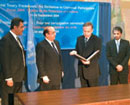 |
 |
24 September 2003
Treaty signing event, United Nations,
New York.
[Read more] |
24 September 2003
Treaty signing event, United Nations,
New York.
[Read more] |
22 June 2004
United Nations,
New York.
[Read more] |
20 November 2009
The Secretary-General meeting youth at Convention on the Rights of the Child event, United Nations,
New York.
[Read more]
|
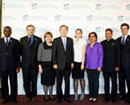 |
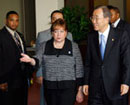 |
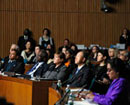 |
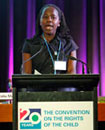 |
20 November 2009
The Secretary-General attending 20th Anniversary for Convention on the Rights of the Child, United Nations,
New York.
[Read more]
|
20 November 2009
20th Anniversary for Convention on the Rights of the Child, United Nations,
New York.
[Read more] |
20 November 2009
20th Anniversary for Convention on the Rights of the Child, United Nations,
New York.
[Read more] |
20 November 2009
20th Anniversary for Convention on the Rights of the Child, United Nations,
New York.
[Read more] |
 |
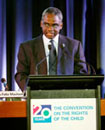 |
 |
 |
20 November 2009
20th Anniversary of Convention on the Rights of the Child, United Nations,
New York.
[Read more]
|
20 November 2009
20th Anniversary for Convention on the Rights of the Child, United Nations,
New York.
[Read more] |
20 November 2009
20th Anniversary for Convention on the Rights of the Child, United Nations,
New York.
[Read more] |
20 November 2009
20th Anniversary for Convention on the Rights of the Child, United Nations,
New York.
[Read more] |
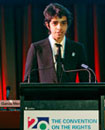 |
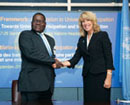 |
 |
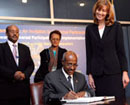 |
20 November 2009
20th Anniversary for Convention on the Rights of the Child, United Nations,
New York.
[Read more] |
27 September 2010
Integration Minister of Central African Republic signing Protocols on Children's Rights, United Nations,
New York.
[Read more]
|
28 September 2010
Foreign Minister of Malta signing Protocol to the Convention on the Rights of the Child, United Nations,
New York.
[Read more] |
28 September 2010
Foreign Minister of Ethiopia signing Protocol to the Convention on the Rights of the Child, United Nations,
New York.
[Read more]
|
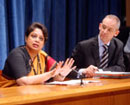 |
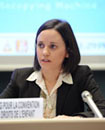 |
 |
|
12 October 2010
Special Representative previews report on State of Children and Armed Conflict, United Nations, New York. [Read more] |
28 February 2012
Signing ceremony for Third Optional Protocol to the Convention on the Rights of the Child, United Nations, Geneva, Switzerland. [Read more] |
28 February 2012
Signing ceremony for Third Optional Protocol to the Convention on the Rights of the Child, United Nations, Geneva, Switzerland. [Read more] |
|
|


























